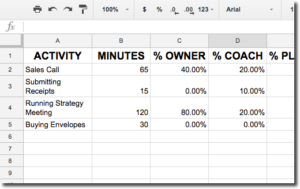My day started off by prepping for an upcoming monthly financial team meeting. Then I went into one-on-one meetings with my direct reports. Lastly, I finished my day by speaking at a leadership conference. To effectively perform each of these activities, I needed a different set of skills and mindset.
As the leader of a team or organization, there are three major team roles that should determine how you are showing up during each activity you perform. To use a sports analogy, the three roles are The Owner, The Coach, and The Player on the Field.
The Owner
 Typically, the owner’s box in a stadium is high up and away from the daily activity on the field. This allows the owner to see the whole field and how individual plays align with the bigger picture. The owner’s mindset is to make sure everything, and everyone, is working together in the right direction. The owner is the gatekeeper of the mission, vision, and core values of the team and organization. The owner strategically thinks and acts at a high level. The owner should be spending most of her time working on the team and organization and not in it.
Typically, the owner’s box in a stadium is high up and away from the daily activity on the field. This allows the owner to see the whole field and how individual plays align with the bigger picture. The owner’s mindset is to make sure everything, and everyone, is working together in the right direction. The owner is the gatekeeper of the mission, vision, and core values of the team and organization. The owner strategically thinks and acts at a high level. The owner should be spending most of her time working on the team and organization and not in it.

The Coach
Coaches are on the field next to their players. By challenging and supporting them, coaches make sure their players are performing at peak levels. The coach trains and guides the players on how to deliver the playbook that was created by the Owner. The coach is working with the players to do the daily work. The coach is checking in on a regular basis to make sure all the players are on track.
 The Player
The Player
The players are on the field are executing the plays. The player is doing the daily activities from the playbook from their coach. Though each player is an individual, players will often work together, with the help of the coach, to perform plays. Players are the front lines of the team and often it’s who the fans (e.g customers/members) see the most. The players are doing the work.
Hopefully when reading through these descriptions, you can see how all three roles are critically important to the overall health of a team and organization. In smaller organizations and teams, it’s very possible for you, as the leader, to bounce between all three roles continuously. In larger organizations, however, these roles become more defined and The Owner should be spending the majority of her time at only the highest levels of strategic thinking and connections with her coaches who, in turn, guide the players.
How Is Your Day Divided?

Curious to know how much of your day you are spending within each team role? Here’s a quick activity to help you figure out.
- Pick an upcoming week that represents a typical work week for you.
- Open our templated Google spreadsheet.
- In column A, list all the activities you did for the week.
- In column B, list how much time (in total minutes) you spent on each activity.
- In columns C, D, and E, list what percentage of that activity falls under each role (Owner, Coach, Player). Make sure columns C, D, and E equal 100%.
- You’ll notice that as you type in the percentages in columns C, D, and E, the spreadsheet will automagically populate how much of your week you are spending within each of the roles.
- Take a moment to answer these reflection questions.
a) What surprised you about your results?
b) How do your results compare to what your ideal role should be like?
c) What’s a blocker that’s limiting your ability to actually get to the ideal role balance?
d) What’s one thing you can do right away to start shifting towards your ideal role balance?
Too often, we see leaders swimming mindlessly between tasks without actually taking a step back and to evaluate what role they are playing in each moment. Each role is critical to the overall health of the team and organization. So take some time to evaluate yourself and find ways to adjust your current workload to better align with the role balance that will best suit your position.




